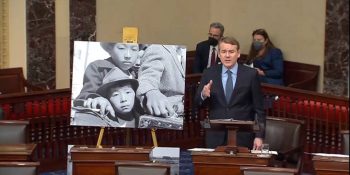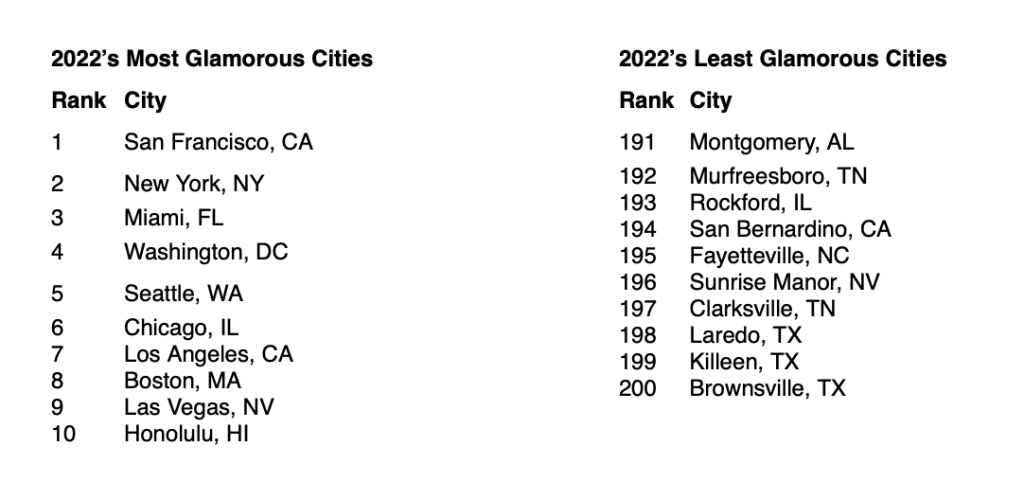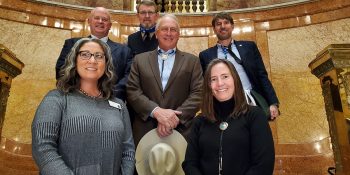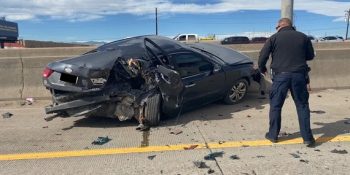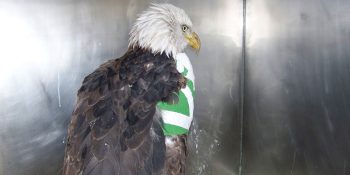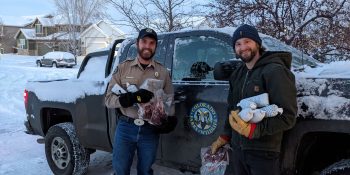After Debate, Bennet and Lee Reached An Agreement On The Floor, Leading to Senate Passage of Bennet’s Bill
VIDEO: Watch Bennet’s Speech HERE
Washington, D.C. – Ahead of the 80th anniversary of Executive Order 9066, which began the forced internment of 120,000 Japanese Americans, Colorado U.S. Senator Michael Bennet passed his bill to add the Amache internment site for Japanese-Americans to the National Park System (NPS). The facility, located in Granada, Colorado, held nearly 10,000 Japanese Americans against their will during the Second World War. Previously, U.S. Senator Mike Lee (R-Utah) had blocked Senator Bennet’s efforts to pass the bill by unanimous consent. Following a debate yesterday on the Senate floor, Senator Lee dropped his objection, allowing the bill to pass.
“I had the opportunity to visit Amache a few years ago with John Hopper, a high school principal in Granada, who worked with his students to create the Amache Preservation Society,” said Bennet in his speech. “They’ve been taking care of this site themselves all of these years, collecting items from all over the world that former prisoners have sent back because they want people to remember, they want a memorial to their captivity. And year after year, these high school students and their teacher have worked to restore the site so that the next generation of Coloradans could learn about what happened there.”
Bennet continued: “And after I visited the site, I introduced a bill with Senator Hickenlooper to make Amache part of the National Park System so that it would have the resources and recognition it deserves for years to come. We have to get this done, Madam President, because the survivors of Amache are growing fewer and fewer in number each year. We have to keep the memory of what they went through alive for the next generation. That’s what Colorado wants.”
Bennet’s bill, which he introduced with U.S. Senator John Hickenlooper (D-Colo.) in April 2021, would chart a path to establish Amache as a National Historic Site and make it part of the NPS. U.S. Representatives Joe Neguse (D-Colo.) and Ken Buck (R-Colo.) introduced companion legislation in the U.S. House of Representatives, which passed by 416-2 in July 2021.
Last year, survivors of Amache sent a letter to Senate leadership urging passage of this legislation and over 70 Colorado and national organizations have expressed their support.
The bill now heads back to the U.S. House of Representatives for consideration.
The full exchange is available HERE. A full transcript is available below.
SENATOR BENNET
Madam President, reserving the right to object, I strongly disagree with Senator Lee’s proposal amending what has been agreed to –– not agreed to –– but what has gotten every single member of the Senate but for one.
I want to also say, Madam President, that I was on the floor about 10 days ago, I think, on the subject of this. And I want, through the Chair, for the Senator of Utah to know, I didn’t even mention who had objected while I was here. But it was one out of 100 senators.
This bill passed the House of Representatives with all but two votes and passed with every single vote from the Colorado delegation. And we have the gamut of people, you know, from Colorado. The bill is strongly supported by my friend Ken Buck, who I ran against in 2010. And if Ken were here, he’d say, there’s very little upon which we agree. I hope there’s more than he thinks we agree on, but we definitely agree on this.
And so let me just explain, Madam President, why we wrote this bill. In five days, as the Senator from Utah has said, we’re going to mark the 80th anniversary of executive order 9066, which began the forced dispossession and internment of over 120,000 Japanese Americans during World War II.
Two thirds of them were citizens of this country. American citizens forced out of their homes into camps by our own government –– by their own government. One of those camps was Amache on the Eastern Plains of Colorado, where the federal government detained nearly 10,000 Japanese Americans against their will.
Most of them had less than a week, Madam President, most of them had less than a week to get rid of virtually everything they owned and crowd onto buses and trains with no idea where they were going, or what was going to happen to them. Some of the first arrivals at Amache were kids younger than the pages that are on the floor here today with us, who were forced to build the camp where their own families were interred during the duration of the war.
The conditions were horrible. The walls didn’t always reach the ceilings, the windows weren’t always sealed. It meant that snow blew in during the winter, dust blew in during the summer. This is what our government did to our fellow Americans, to children, forced to work in the fields to grow their own food in the jail that the United States of America had committed them to.
And what’s even more remarkable is that despite this treatment, one out of ten of the people at Amache still volunteered to serve during the war –– a higher rate than any other camp in America. Think about that. They were willing to defend the very government that was detaining them, that had locked up their children. That’s how much they believed in America, even when America turned our back on them.
And I had the opportunity to visit Amache a few years ago with John Hopper, a high school principal in Granada, who worked with his students to create the Amache Preservation Society. They’ve been taking care of this site themselves all of these years, collecting items from all over the world that former prisoners have sent back because they want people to remember, they want a memorial to their captivity.
And year after year, these high school students and their teacher have worked to restore the site so that the next generation of Coloradans could learn about what happened there. If it were up to me, Madam President, every student in Colorado and throughout the American West would go there –– throughout our entire country –– and learn about the Americans of Amache. The men and women who held on to hope year after year, who supported one another, who forged a community behind the barbed wires of the site, who never gave up on the United States of America, even as it was interning them on their own soil.
And after I visited the site, I introduced a bill with Senator Hickenlooper to make Amache part of the National Park System so that it would have the resources and recognition it deserves for years to come. We have to get this done, Madam President, because the survivors of Amache are growing fewer and fewer in number each year. We have to keep the memory of what they went through alive for the next generation.
That’s what Colorado wants, Madam President. I have a list of over 70 groups that support it from the Asian Chamber of Commerce, to the Colorado council of churches to the town of Granada, who owns the site today. So Madam President, I’d ask unanimous consent to enter this list into the record.
CHAIR
Without objection.
SENATOR BENNET
Thank you, Madam President. This bill wasn’t controversial in Colorado and it wasn’t controversial in the House, where Republican Congressman Ken Buck, whose district this is, took up the bill with Joe Neguse, a neighboring congressman. Amache is in Ken’s district, in Prowers County. And I said that the bill passed the House 416, I think it was, to two.
And it wasn’t controversial in the Senate Energy and Natural Resources Committee where it passed with bipartisan support from the chairman and ranking member. And that’s why I came here two weeks ago to pass the bill by unanimous consent. But now there’s been an objection.
And I should mention, by the way, that this site is less than one square mile. It is a tiny, tiny fraction of even the county that we’re in. And it seems to me that we shouldn’t, if we believe in federalism at all, we shouldn’t be blocking Colorado’s right to preserve less than one square mile the way we see fit. That we shouldn’t have to reduce the public lands of the United States by an equal amount. And I’ll say, in that connection, Madam President, that I formally object to the Senator from Utah’s motion, for this reason.
The land here is owned by Granada. It’s already public land, the town has said it wants to donate it to the National Park Service. I have a letter from the town making this intention perfectly clear. So it’s not even private land that’s becoming public, it’s public land, transitioning from a local government to the federal government at the request of the community.
And they’re not asking for anything in return. And I think that’s an important point that the Senator from Utah has raised. And we’ve worked with the town to show that they’re not asking for an exchange, they want to donate the land as their patriotic contribution to America to protect this part of our history. And I would think all of us here should agree that unless it’s hurting somebody else, a town can do whatever it likes with its own land, just like a private landowner can do with their own land.
I also –– let me stop there, Madam President, and see whether the Senator from Utah has any reaction to that. I will formally object to his motion. And I’ll stop there. And I’ve got other things to say. But I hope that maybe we can get to an agreement based on what I would offer. So I object.
CHAIR
Objection is heard.
SENATOR LEE
Madam President?
CHAIR
Senator from Utah
SENATOR LEE
Yeah, a couple of points. I don’t think we’re far off in where we are on this. It is true that it’s not an expanse of land that is as big as some other land transfers we see. One square mile. On the one hand, a lot of people would regard that as large –– 640 acres, is the acreage equivalent of one square mile.
I would note here, I wouldn’t call it a federalism argument that we have to allow this. There are federal implications to this that extend far beyond what a local unit of government might want to do. Because what happens is when you transfer it into the federal estate, we do incur additional obligations to make sure that that land is maintained and managed appropriately.
It does cost money, and it takes an expense off the books of those who would otherwise be maintaining it. So it’s not without any consequence at all. And nor is it a matter of simple operation of federalism, to say that we should allow this in this circumstance.
I would note, moreover, that we’ve come closer on this. The amendment that I offered a moment ago that my friend and colleague, the Senator from Colorado objected to, is one that would allow this to happen, but would require an offset to be made by the appropriate federal land managers within one year of the transfer of this land.
There’s nothing about that that strikes me as particularly objectionable, particularly given the fact that the federal government owns and manages about 30% of the landmass in the United States. In my state and in Colorado, it’s much more than that. But it was nothing about that that should be particularly objectionable.
That said, the Senator from Colorado has shaped this legislation in a meaningful way. And because I’ve got a desire to honor those victims of this horrific event in American history, and the Senator from Colorado has offered up a separate solution, one that would involve donation rather than acquisition by the federal government, and although that also raises some concerns in that over time, I think we’ve got to watch this because the more we enhance the federal land footprint, the more difficult it will be for the federal government to keep up with the maintenance backlog.
But given that this doesn’t directly impact concerns quite the way that those same concerns might be implicated if we were having to purchase it at the outset, I’d be inclined if my friend from Colorado were interested in offering that amendment, to withhold any objection from that, while noting that it’s my hope and expectation that moving forward, we can be more aware of these issues, and that as we see the federal land footprint increasing, we can take steps as a body to make sure that there’s some natural stopping point, even before we turn to what I believe we still have got to turn to, which is the commitment made at statehood, that still needs to be honored.
SENATOR BENNET
Madam President?
CHAIR
Senator from Colorado
SENATOR BENNET
I thank, through the Chair, through the President, the Senator from Utah and I think –– let me start, Madam President, by saying that I ask unanimous consent that the Senate proceed to the immediate consideration of calendar 255 HR 2497. Further I ask the Bennet amendment at the desk be considered and agreed to the committee reported amendments be agreed to the bill as amended, be considered read a third time and passed, and that the motions to reconsider be considered made and laid upon the table?
CHAIR
Is there objection?
SENATOR BENNET
Madam President?
CHAIR
Senator from Colorado
SENATOR BENNET
This is all happening on the fly right now. So I’m actually going to withdraw that, in the spirit of what Senator Lee has said. Hopefully, we can do this later today. We need to make sure that everybody has the benefit of seeing the language and then we’ll be back later to do this.
So I thank the Senator from Utah and I will spare him the rest of my speech, except I think he deserves to hear this, and I think everybody here deserves to hear this, which is when the E&R Committee took this legislation up this fall, here’s what the survivors from Amache wrote to the committee, and I just want to put their words into the record before I withdraw:
“During World War II…” –– this is their words –– “During World War II, we were forced to live as prisoners in our own country. Along with our parents, we were forced from our homes, tagged like animals and sent to the desolate prairie of southeast Colorado, where we lived in trauma. A constant presence of armed guards, barbed wire and suffering too large to describe in one correspondence. Our families suffered loss of jobs, homes, property and businesses, and many of us lost family members. Many of our parents went to their graves without even an apology from their country. Our nation still has a long way to go to learn from this mistake. And our community, both old and young, continues to suffer from anti-Asian hate crimes increasing to this day. Our National Parks and the stories they honor reflect our values as a nation. Adding Amache to the National Park System would allow us to protect a unique story that has largely been forgotten and can only be told through the power of place. With each year that passes, there are fewer of us. We are counting on you to see us through.”
And because of the discussion we’ve had tonight, we’re going to have the chance later to be able to do that. I thank my friend from Utah and I thank the Presiding Officer. I yield the floor.

